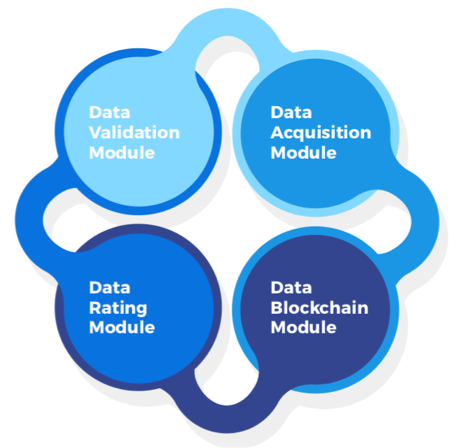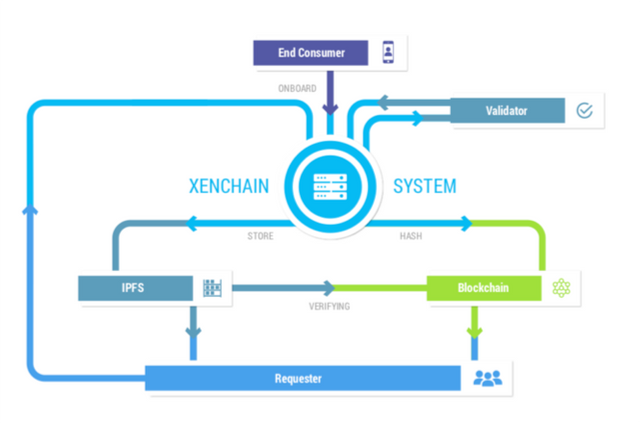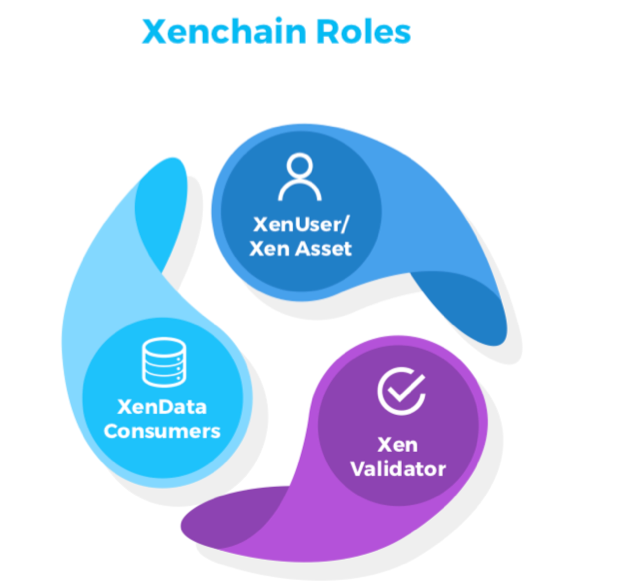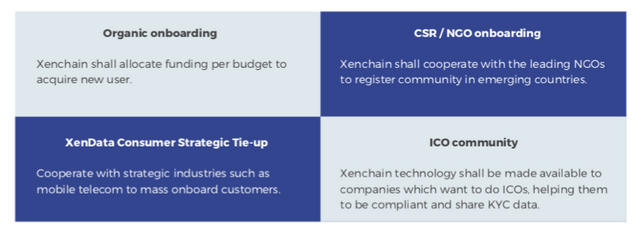
In consumer market Internet technologies simplify transactions, payment and delivery of goods, allow to book services in advance.Online banks, stores, and social network hold the data about users. However, owners of companies cannot use these scattered data, and clients have to enter hundreds of logins and passwords every day. Is it possible to accelerate the process, make data beneficial for business and store them securely?

Picture 1. A common scheme of Xenchain working: verification, storage, and users’ data output according to their rating in the system
The Xenchain team offers the unified platform, which will solve these problems. The Xenchain platform is created on the basis of Blockchain. It stores personal data and offers ordinary customers to decide themselves, what information to give business owners. For instance, the data about amounts and dates of purchases can be stored encrypted. An owner can see only a list of branches visited by the client.
What is Xenchain?
The Xenchain platform implements the KYC procedure “from both sides” quickly and effectively. A user enters his personal data in a user-friendly way, and a business owner receives the reliable information for forming a base of accounts. For instance, to get an access to an online platform, a new customer photographs and scan his bank card; the owner of the platform creates the base of contacts for marketing research, mailing lists, and loyalty programs.

Picture 2. Technical implementation of Xenchain: consumers’ data pass validation (Validator) are stored in Blockchain and transmitted through the secure protocol
The main asset of the platform is PII (Personal Identifiable Information), a set of user's personal data, which provides access to the system and work in it. For instance, in social networks, these are photos and contact information of a user.
The app efficiency is provided by four units:
● Acquisition module. The collection of data is held by means of devices of scanning and recognition of photo, voice records, fingerprints, documents and forms filled by clients. The module is already inside the majority of contemporary apps, but Xenchain technology is more transparent and prompt.
● Validation module. The data are checked by companies or private persons providing the completeness and relevance of information. For example, by filling the account on a social network the information is sent to the admin for verification. It reduces the number of unused accounts, brings down costs of regular “cleaning” of a customer base.
● Blockchain module. Relevant and ordered data are stored on the decentralized servers. The users and the business owners have the access to information themselves, and the transparent architecture excludes doubling.
● Rating module. Users’ data get rating dependent on their completeness and accuracy. The participants of Xenchain can communicate and share their opinions in the social network.

Picture 3. The supposed roles of users in the Xenchain system: the owner of data, the verifier and the user of the information.
According to Whitepaper, the developers assume three primary roles for each user.
● XenData Consumer is a person or an organization, requesting the verification of Xenchain user’s ID. This role gives the right to use SDK, an interface of the applied programming for evaluation of the given data. For instance, if an online bank approves a loan to young families, the SDK includes a module to search for data on birth certificates of children.
● XenUser (asset) is an individual user or asset (a flash drive, a hard drive) containing personal information about users. Such data are processed only after the acceptance of their users.
● XenValidator is a participant of XenChain, who holds user’s validation, by asking questions and checking additional documents.
How does Xenchain work?
A flexible Blockchain technology allows configuring authentication according to certain system requirements. For example, mobile operators require to enter the phone and agreement numbers, medical centers “identify” their clients by passport data. A user enters the information, he wants to share with the system, and the rest of the information gets encrypted and is stored on servers.
The verification of a user is carried out in three stages.
● Identity Onboarding is a process of creation of a new account in the XenChain system. The OCR tool (optical character recognition) allows the platform “reading” downloaded documents, filling user’s profile automatically. These documents usually are the passport, the driving license, the insurance.
● Data Bio-matching is a process of comparing documents with personal data of a new user. The program compares photos on the official papers with a current appearance of the user (photo or video). Then XenValidator asks a newcomer personal questions (the place of work, the level of income, the address) according to the official information got from governmental or commercial entities cooperating with Xenchain. It is available for ordinary platform participants with high ratings to approve the personality of a user. This will accelerate the process and support trust towards Xenchain.
● Data Validation. The certified information is stored in the platform blockchain, and copies of documents are distributed across authorized protocols for personal data. There is an encrypted key in the application, which gives a user the access to the data. Such a peculiarity protects the information of users from fraudsters, brings down the number of data “in the circulation”.
Users’ data are stored according to IPFS protocol (InterPlanetary File System), which is a distributed file system resembling torrent-trackers in the sense of its logic. Users exchange links (encrypted keys), on opening of which the user’s ID is approved. Documents are loaded only after the request, regularly updated by users, and verified by XenValidator.
XEN token, created according to the ERC20 standard, will be used as a tool for stimulating users, giving their personal data. The work of XenValidator (data validation) and XenUser (providing the personal data) will be paid with XEN tokens.

Picture 4. Business-model of the project: the creation of users’ community, the cooperation with companies, the simple inclusion of new participants and the entrance to the developed markets with help of noncommercial organizations
According to materials on the website, the Xenchain founders are planning to use the platform for ICO of projects, services for travelers (booking hotels, tickets), gaming, eCommerce, social networks of different kinds, money transfers and digital banking frameworks.
How is Xenchain developing?
According to Roadmap of the project, the development of Xenchain is divided into three stages:
● Pre-ICO (January - March 2018) was devoted to MVP creation and its trial start for corporate clients. In March 2018 a corporate XenValidator was prepared, then it was the structure design and the legal registration of the entire project. Good news for the investor is that Whitepaper was created after the start of MVP, so the team was evaluated on taking real data into consideration.
● ICO conducting (March-May 2018) is devoted to releasing of the beta version of Xenchain with a function of storing of personal data in the decentralized system. Participation in ICO requires passing the KYC procedure, developed by Xenchain. The team is upgrading technologies, allowing potential investors to evaluate its quality. After that, the platform’s sales campaign will be launched in Asia and Europe.
● Post-ICO (May - December 2018) will be devoted to attracting 10 million users, and also the spread of the platform on the Middle East, the Asia and Pacific, the North Europe and the CIS countries.
The distinguishing feature of the team’s Whitepaper is that it’s well conceived. There are target markets pointed, and the strategies of further development are analyzing in much detail. From the investor’s point of view, the project is promising thanks to the sequential marketing: there are many apps of this kind, but exact strategies of the development are rare.
The team continue upgrading Xenchain, however, the basic version is ready for usage. Further plans are connected with increasing the number of sales. Unlike many ICO, essential technological changes are not planned to take place, the project is based on successful technologies, tested in real market conditions.
Summary
The Xenchain platform is created to simplify the KYC procedure and arrange users’ data in business. The creators are focused on the B2B segment and are planning to win markets by regions and segments. During the PrivateSale more than 35% tokens will be sold to chosen participants and partners of the platform. It is also the approval of good image of the creators.
What’s great about Xenchain for the investor? It has a detailed business plan and almost finished product. The concept of the platform is not groundbreaking, but the development and orientation towards many national markets suppose a high profit.
What is the probability of Xenchain success?
The partners of the project are Xendity and IntelWise, among the advisors, there is executive Director of audit firm “PriceWaterhouseCoopers”.
Hello! Good article! I'm interested in the them of ICO and crypto-currency, I'll subscribe to your channel. I hope you will also like my content and reviews of the most profitable bounties and ICO, subscribe to me @toni.crypto
There will be a lot of interesting!
Downvoting a post can decrease pending rewards and make it less visible. Common reasons:
Submit